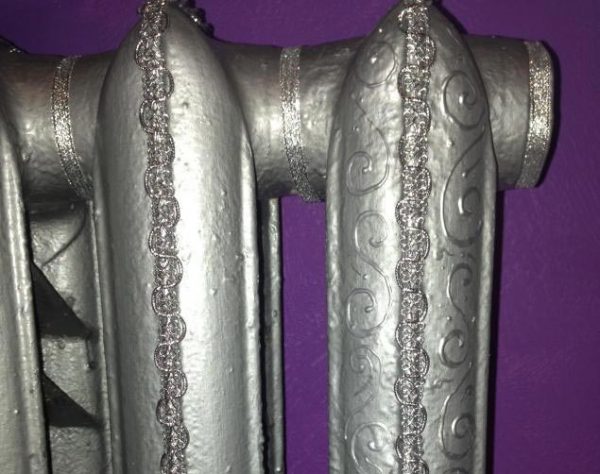By silver we mean powder from aluminum. When applied to the surface, it creates a beautiful layer of metallic color, reminiscent of the luster of steel. This tool can be implemented in a dry, pasty form, it is intended for the manufacture of paint. It is important to know how to breed silver for painting metal, and how to do it correctly.
- Types and composition of silverfish
- Pros and Cons of Silverfish
- Paint dilution
- Tips for painting silver

Types and composition of silverfish
In fact, the paint got its name not because of the presence of particles of silver, but due to the corresponding color. Serebryanka is an aluminum finely divided powder of a light gray steel shade. This powder product is used for diluting and staining various surfaces. Thus, the base for the paint is obtained from aluminum waste by crushing. There are no other components in the silverfish itself.
There are two types of silverfish - PAP1, PAP2. The difference in particle size, the proportion of dilution of the material. The first option is made from larger particles, the second - from the smallest. Both production methods comply with GOST 5631-79. Also, recently, ready-made thick material has appeared in stores - PD silver paste. It costs more, but for painting surfaces it is much more convenient to use it - you just need to dilute it. BT-177 paint, already diluted, is on sale; it is completely ready for application.
to contents ↑Pros and Cons of Silverfish
The material has a lot of advantages. It is perfect for interior work, because after drying it becomes non-toxic, 100% harmless. Although the smell is present during operation, safety measures must be observed. Other advantages of paint:
- securely adheres to the base, has good adhesion, lasts a long time;
- able to dry quickly, does not require a long absence of tenants in the room;
- gives the metal anti-corrosion properties, resistance to UV radiation;
- it is easy to apply paint, it does not leave stains, sagging;
- any material can be painted with silver, not only metal;
- the finished paint is stored in a sealed container for up to 6 months, dry powder does not deteriorate much longer;
- paint can be diluted in different proportions with a solvent, so the finished shades will vary;
- decorative properties of the material are high, it improves the appearance of metal, old wood.
Now some types of silverfish contain additional additives (for example, liquid glass), which gives enhanced fire fighting properties. The paint itself is heat-resistant, it can even be applied to stoves, potbelly stoves, batteries, radiators, pipes. In industry, it is used for painting boiler rooms, bridges, underwater parts of ships, various tanks, parts. You can dye silver products that are operated on the street under the influence of temperature extremes, in aggressive conditions.
to contents ↑The disadvantages include the lack of the ability to paint with silver with the windows closed.Must have to buy a respirator, gloves. The powder itself is explosive prior to application. After drying, the surface will be vulnerable to contamination, it is difficult to wash it due to the non-smooth structure. Also, the material will not lie on oil, alkyd paints, nitro enamels, they will have to be completely removed.
Paint dilution
Serebryanka is excellently varnished. The diluent is the heat-resistant varnish BT-577, which is intended for PAP1 powder. For PAP2, any varnish can be used. The procedure for dissolving PAP1 is as follows:
- pour 2 parts of dry material into a container;
- add 5 parts of varnish;
- mix well until a homogeneous mass is obtained.
BT-577 varnish further enhances the heat-resistant properties of silverfish, therefore it is recommended to use it if the paint will be applied to surfaces subject to heat. In other cases, you can use PAP2. It must be diluted in a different proportion: 3-4 parts of varnish are taken for 1 part and mixed well (about 5-7 minutes). If the portions of the product are large, it is better to use a construction mixer or drill with the appropriate nozzle.
Also silverfish can be bred with synthetic drying oil. The only downside is that the finished product will not have heat resistance, as after adding varnish. Natural drying oil is not suitable, it will not provide sufficient uniformity of the paste. PAP1 is diluted with drying oil 2: 5, PAP2 - 1: 3 or 1: 4.
Next, you can bring the paste to a state in which it is suitable for painting. You will need to dilute it with turpentine or solvent, as well as another organic solvent. The ratio with diluent depends on the method of application of the paint.
If you decide to work with a roller, then the paste needs 2 parts per 1 part of the solvent. For application by brush and spray gun, the proportion is 1: 1. To dilute the finished store paint, which is slightly thickened, use solvent 646 (up to 20% of the total paint volume). To change the color in silver, you can enter special pigments.
to contents ↑
Tips for painting silver
Before painting, you need to properly prepare the base - clean from dirt, rust, sand. Serebryanka does not require the use of soil. It is advisable to apply it in 3 layers, waiting for the previous one to dry. After completion of painting, it is necessary to varnish with the same varnish that was used for dilution. This will increase the durability of the finished layer.









Hello, but you can explain to the dunce (that is, to me) how much to add powder by weight, and not in parts, I have a bucket of varnish 10 liters how much to add P2 powder, thanks in advance for the answer.